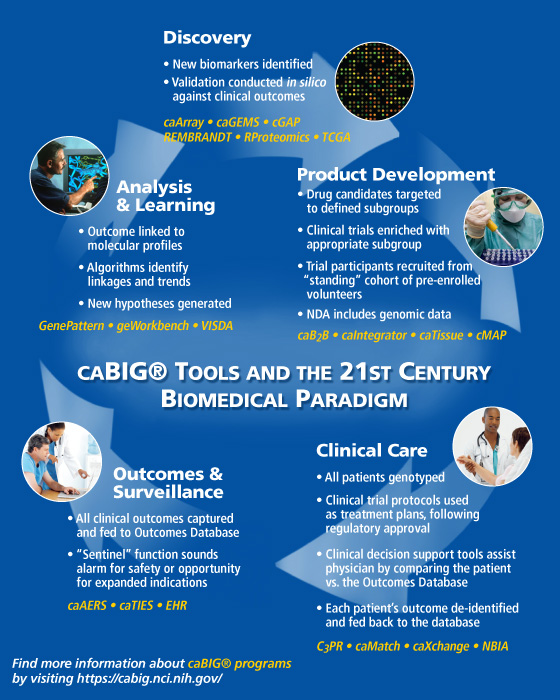
A Conversation with Dr. Kenneth Buetow
 Dr. Kenneth Buetow
Dr. Kenneth Buetow
Director of NCI's Center for Biomedical Informatics and Information Technology and leader of the caBIG® (cancer Biomedical Informatics Grid) initiative, which provides bioinformatics infrastructure and a portfolio of more than 40 tools that enable organizations and individual researchers to securely share biomedical data.
How has caBIG® addressed interoperablity with the proprietary systems in place at some institutions?
There are two paths to connect with caBIG®: "adoption" and "adaptation." Many institutions choose a hybrid approach of adopting some caBIG® tools and adapting some of their existing IT infrastructure using published compatibility guidelines to become caBIG®-compliant. All caBIG® tools and information are released under a "non-viral" open-source license that allows commercial reuse of caBIG® technology, so that vendors may become caBIG®-compatible. We have adopted internationally recognized data standards or worked with professional organizations to develop vocabularies, common data elements, and data models where such standards did not exist or were inadequate, simplifying our ability to connect with other systems. Because caBIG® supports data federation, organizations maintain control over their own data. We recently demonstrated health data exchange between systems at the Department of Defense and Kaiser Permanente using interoperable caBIG® clinical trials management software, bridging what has traditionally been perceived as an insurmountable chasm between research and care.
How are issues surrounding information security addressed?
The Data Sharing and Intellectual Capital Workspace of caBIG® addresses this issue, and provides guidelines and tools to help researchers evaluate the sensitivity of their data and address federal privacy regulations, human participant protections, sponsor contract compliance, and proprietary interests. In addition, the caGrid architecture is based on the open-source Globus toolkit with additional enhanced security infrastructure that provides services and tools for the administration and enforcement of security policy.
What is next for caBIG®?
The past year has been one of huge accomplishments for the caBIG® program. Fifty NCI-designated Cancer Centers and members of the NCCCP have connected to each other via caGrid, creating the world's largest dedicated biomedical research grid, with more than 120 active grid nodes. To support the continued growth of the community, the Enterprise Support Network was established, composed of six Knowledge Centers, each supporting a scientific domain or collection of caBIG® tools. In addition, Support Service Providers—almost 20 to date—assist researchers and organizations who are connecting to caBIG® and require training, installation, or tool customization, on a fee-for-service basis.
Beyond the United States, caBIG® and the National Cancer Research Institute in the UK have been working together and adopting complementary technologies for years. Several caBIG® members recently traveled to India to meet with representatives of the health ministry, leading research hospitals, and the Center for the Development of Advanced Computing. We look forward to many more productive interactions in the future. In a vote of confidence for the quality and usefulness of caBIG® technology, the King Hussein Medical Center in Amman, Jordan, recently decided to implement caBIG® infrastructure across the entire hospital to provide data interoperability.
For more information on the caBIG® program, I encourage everyone to read the recently published caBIG® 2008 Annual Report at http://cabig.cancer.gov/gettingconnected/caBIGresources/annualreport/.
